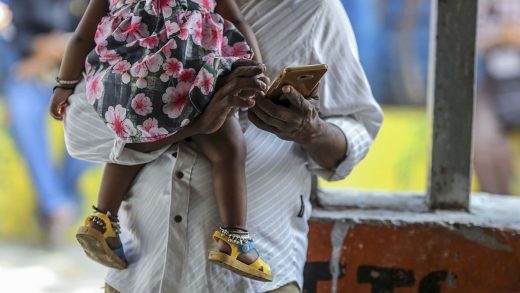![]()
Two weeks before the much-anticipated exhibition “Wolfgang Tillmans: To Look Without Fear,” opening Wednesday at the Art Gallery of Ontario, I bought a pair of cartoonishly grape-coloured Adidas Gazelles. The iconic streetwear shoe debuted in 1968, the same year the beloved photographer was born in Remscheid, Germany.
My long-coveted footwear is modelled after the sneaker’s 1991 design, popular around the time Tillmans was capturing post-Cold War youth subcultures in Europe for scenester publications including i-D, Interview and Butt. Unabashedly frank, yet playful in his subjects’ frequent nudity, it is this striking but tender portraiture for which Tillmans is best known. But there is so much more revealed throughout this massive yet airy AGO show that surveys Tillmans’ repeated interrogations into subjects as diverse as the human body and sexuality, astronomy, politics, war, architecture, music and the material nature of paper. There is palpable sorrow and joy, humour, loss and a sense of reclamation.
Organized by the Museum of Modern Art, the touring “To Look Without Fear” features more than 400 photographic, video and audio works created over a 35-year period that saw the German artist receive the 2000 Turner Prize, becoming the first non-Brit honoured with the prestigious award. The show covers his work on film and his transition to digital photography, as well as images created in the darkroom without a camera. The AGO’s Jackman Hall will also be screening “Moon in Earthlight,” Tillmans’ 2021 album and accompanying 53-minute video, including “Insanely Alive,” a single remixed by the Pet Shop Boys.
The show takes advantage of the gallery’s expansive fifth-floor space with arrangements of unframed prints affixed to the walls with bulldog clips and tape, adjacent to works with fine-art framing, combining editorial clips from magazines with casual and posed portraiture of friends and celebrities.
Divided into zones, there is no hierarchy to the subjects: in the corner of one wall is a small cluster of recognizable faces, including Canadian artist Bruce La Bruce and supermodel Kate Moss posing with a head of broccoli. Two large prints, one of a suit and the other of a beautifully lit blue cloth, ground this wall in studies of drapery, while in the middle there is a grid of 56 photos from 1997 of Concorde airplanes flying over London, their rocketlike shapes looking very much like sci-fi artifacts.
For each iteration of the travelling show, Tillmans reprints works, originally shot in three standard sizes, taking in the height and architectural details of the individual locations, including the light-grey steel beams around a door at the AGO, to which two Hong Kong street-scene photos from 1993 and 2018 are affixed. “The exhibitions need so much attention and so much care — they can’t be rushed, really,” he said. “It takes a full 14 days to install this and make it seem so light and effortless.”
Tillmans doesn’t usually organize his shows chronologically, but it was appropriate for what the 54-year-old calls a “retrospective ‘perspective,’” given that he hopes he has at least 30 more years of creating art ahead of him.
“The chronological approach of the exhibition allows visitors to have a moment of what it looked like in the early and the mid-’90s, late ’90s, around the 2000s and the different zones and experiences,” Tillmans said. Sitting on a bench near the entrance, he pointed out the circularity of the show and his pleasure that some of the older works sit in relationship to more recent images, “reaching hands, so to speak.”
But back to those Adidas shoes and their connection to Tillman. One of the first images encountered is 1986’s “Lacanau (Self).” While on a beach, 18-year-old Tillman took what he now considers to be his first self-portrait. Shot downward through a point-and-shoot camera, the burgeoning talent captured his knee framed by the sand, with just a crescent of that familiar Adidas logo and its triad of stripes visible under his flesh.
On the opposite wall, there is another full-body self-portrait from 1988 with Tillman posing poolside, wearing a revealing red Adidas swimsuit, surrounded by a pattern of wet footprints. In the second room, there is the 2000 photo of “Cliff,” wearing an Adidas jacket and shorts, leaning against a wall in a way that wouldn’t look out of place today on Instagram. Another photo in this room features a pair of those familiar black shorts attached to an invisible line chained above a chair as if defying gravity, with a pair of well-worn Birkenstocks on the floor, giving the image a ghostly feel.
Tillman laughed when I asked about the Adidas brand’s personal significance. “It’s apparel for athletes, and me distinctly not being an athlete and not liking sports … it’s still maybe bridging an attraction to a realness of sorts,” he said. “I actually don’t want to be part of a uniformed body and hence the play with it. Using it as a marker of individuality is kind of contradictory, but it is a function of clothes in subcultural appropriating.”
He’s not sure why this Adidas-spotting has been noted by people who have seen the show but, for me, that is part of the beauty of Tillmans’ work. We all bring our own personal touchstones to many of his images, whether it’s the appearance of a certain clothing brand or pleasurable memories of our own nights sweating alongside strangers and friends on a crowded dance floor. The context or years can shift, but there is something universal in the intimacy of two men kissing as if they are the only two people in the world. “The Cock (kiss),” taken in 2002, went viral on social media after the 2016 mass shooting at the Pulse nightclub in Orlando, Florida, as a way of healing and showing solidarity to the community.
That said, Tillmans avoids nostalgia in the images themselves, which can create an artifice between the work and the viewer — and can also be deadly to an established artist’s career. But he understands that might be the emotional response to some of his work, even for people who weren’t alive or who were just toddling around 35 years ago. The show does come at the peak of a ’90s stylistic throwback, with the return of the bucket hat and slip dress, and popular TV shows like “Yellowjackets” with its carnivorous teens recreating the era.
“Many people coming to see the show were either not even born in the early ’90s or they were 10 years old,” Tillmans said. “Anybody younger than 45 hasn’t really been necessarily able to see what things looked like at the time.”
Some younger visitors might have also discovered Tillmans through his work with Frank Ocean. Tillmans’ photo of the iconic rapper and songwriter (which appears in the show), graced the cover of his 2016 album “Blonde.” Tillmans’ own song “Device Control” appears as a sample on the intro of Ocean’s “Endless” album, with the full track serving as its outro.
There are very few artists I can think of — other than perhaps fellow photographer Nan Goldin, to whom he’s been compared — who have managed to maintain this coolness and relevance through several decades, but it is important to note that Tillmans has never sought to be “trendy or fashionable.”
“I was never afraid of being of my time. Because what comes with being of your time is the potential to become outdated, out of fashion. That is something I understood early on,” he said. “There’s literally nothing you can demand or control so that people in 25 years’ time will be interested in you.”
Tillmans views all his work as ongoing experiments, including portraiture, a form he feels he will never master.
“It’s always an experiment to see if another picture is possible,” he said. “It’s quite unlikely that another picture is needed. After thousands and millions of portraits in the world, what is the meaning of another depiction of a person? There is no clear answer to that. Humankind has been at it for a long time, and all my work is in trying to not be burdened down by the knowledge of art history, but also always working in the context of it.”
There is a humility in Tillmans’ portraits that is palpable to a viewer. Even with his more famous subjects, I can feel this relationship between photographer and subject as they reveal their insecurities to each other and, by extension, to viewers.
“I’d rather have an air of inquiry rather than a certainty around my pictures,” Tillman said. “As long as I’m curious about the world, I can make more pictures.”
Wolfgang Tillmans: To Look Without Fear runs until October 1 2023. For more information and tickets go to ago.ca. @AGOToronto | #SeeAGO
JOIN THE CONVERSATION
does not endorse these opinions.



